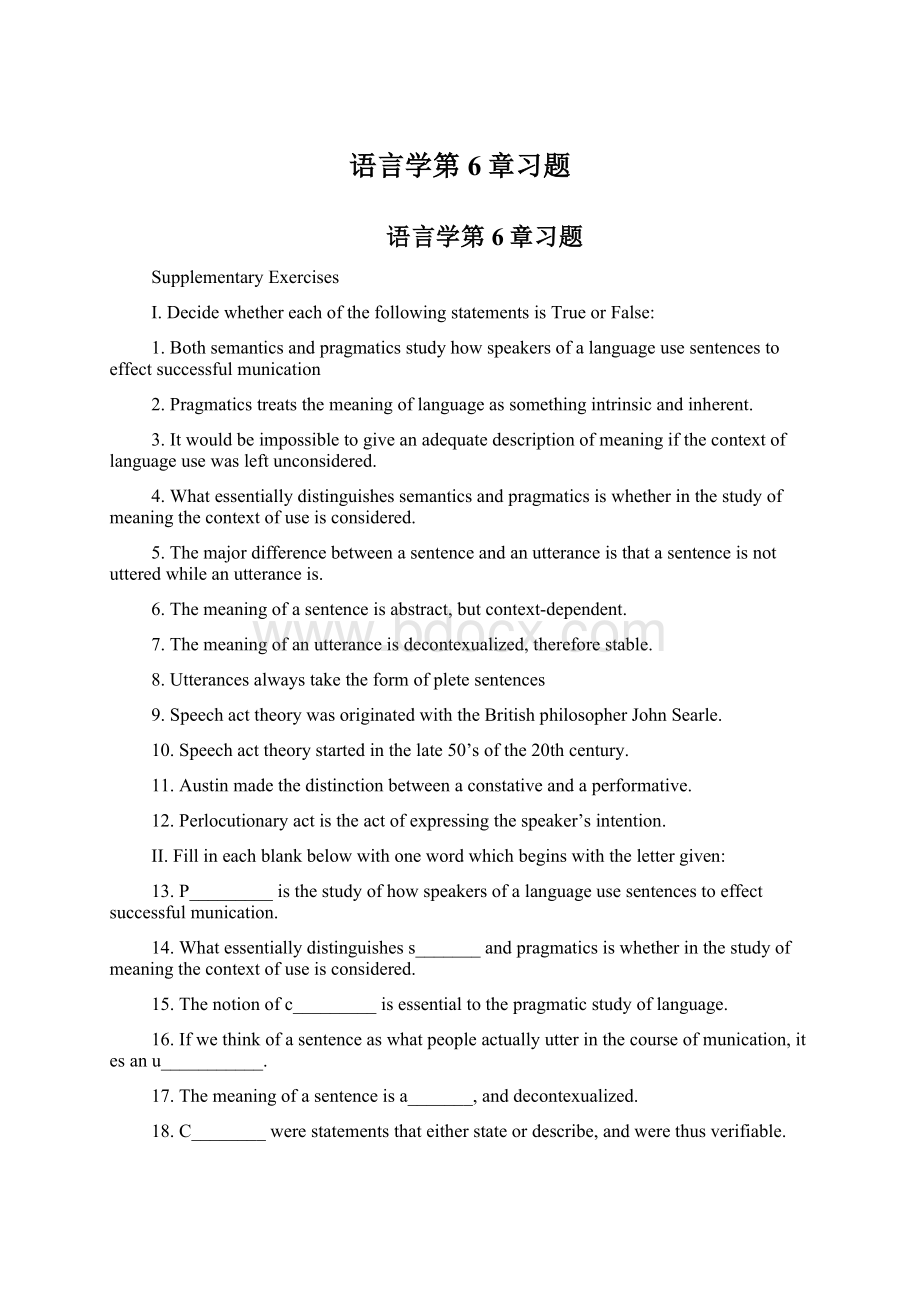语言学第6章习题.docx
《语言学第6章习题.docx》由会员分享,可在线阅读,更多相关《语言学第6章习题.docx(8页珍藏版)》请在冰豆网上搜索。

语言学第6章习题
语言学第6章习题
SupplementaryExercises
I.DecidewhethereachofthefollowingstatementsisTrueorFalse:
1.Bothsemanticsandpragmaticsstudyhowspeakersofalanguageusesentencestoeffectsuccessfulmunication
2.Pragmaticstreatsthemeaningoflanguageassomethingintrinsicandinherent.
3.Itwouldbeimpossibletogiveanadequatedescriptionofmeaningifthecontextoflanguageusewasleftunconsidered.
4.Whatessentiallydistinguishessemanticsandpragmaticsiswhetherinthestudyofmeaningthecontextofuseisconsidered.
5.Themajordifferencebetweenasentenceandanutteranceisthatasentenceisnotutteredwhileanutteranceis.
6.Themeaningofasentenceisabstract,butcontext-dependent.
7.Themeaningofanutteranceisdecontexualized,thereforestable.
8.Utterancesalwaystaketheformofpletesentences
9.SpeechacttheorywasoriginatedwiththeBritishphilosopherJohnSearle.
10.Speechacttheorystartedinthelate50’softhe20thcentury.
11.Austinmadethedistinctionbetweenaconstativeandaperformative.
12.Perlocutionaryactistheactofexpressingthespeaker’sintention.
II.Fillineachblankbelowwithonewordwhichbeginswiththelettergiven:
13.P_________isthestudyofhowspeakersofalanguageusesentencestoeffectsuccessfulmunication.
14.Whatessentiallydistinguishess_______andpragmaticsiswhetherinthestudyofmeaningthecontextofuseisconsidered.
15.Thenotionofc_________isessentialtothepragmaticstudyoflanguage.
16.Ifwethinkofasentenceaswhatpeopleactuallyutterinthecourseofmunication,itesanu___________.
17.Themeaningofasentenceisa_______,anddecontexualized.
18.C________werestatementsthateitherstateordescribe,andwerethusverifiable.
19.P________weresentencesthatdidnotstateafactordescribeastate,andwerenotverifiable.
20.Al_________actistheactofutteringwords,phrases,clauses.Itistheactofconveyingliteralmeaningbymeansofsyntax,lexiconandphonology.
21.Ani__________actistheactofexpressingthespeaker’sintention;itistheactperformedinsayingsomething.
22.Ac_________ismitthespeakerhimselftosomefuturecourseofaction.
23.Ane________istoexpressfeelingsorattitudetowardsanexistingstate.
24.Therearefourmaximsunderthecooperativeprinciple:
themaximofq_______,themaximofquality,themaximofrelationandthemaximofmanner.
III.Therearefourchoicesfollowingeachstatement.Markthechoicethatcanbestpletethestatement:
25._________doesnotstudymeaninginisolation,butincontext.
A.PragmaticsB.Semantics
C.SenserelationD.Concept
26.Themeaningoflanguagewasconsideredassomething_______intraditionalsemantics.
A.contextualB.behaviouristic
C.intrinsicD.logical
27.Whatessentiallydistinguishessemanticsandpragmaticsiswhetherinthestudyofmeaning_________isconsidered.
A.referenceB.speechact
C.practicalusageD.context
28.Asentenceisa_________concept,andthemeaningofasentenceisoftenstudiedinisolation.
A.pragmaticB.grammatical
C.mentalD.conceptual
29.Ifwethinkofasentenceaswhatpeopleactuallyutterinthecourseofmunication,itesa(n)_________.
A.constativeB.directive
C.utteranceD.expressive
30.Whichofthefollowingistrue?
A.Utterancesusuallydonottaketheformofsentences.
B.Someutterancescannotberestoredtopletesentences.
C.Noutterancescantaketheformofsentences.
D.Allutterancescanberestoredtopletesentences.
31.Speechacttheorydidnoteintobeinguntil__________.
A.inthelate50’softhe20thecentury
B.intheearly1950’s
C.inthelate1960’s
D.intheearly21stcentury.
32.__________istheactperformedbyorresultingfromsayingsomething;itistheconsequenceof,orthechangebroughtaboutbytheutterance.
A.AlocutionaryactB.Anillocutionaryact
C.AperlocutionaryactD.Aperformativeact
33.AccordingtoSearle,theillocutionarypointoftherepresentativeis______.
A.togetthehearertodosomething
B.tomitthespeakertosomething’sbeingthecase
C.tomitthespeakertosomefuturecourseofaction
D.toexpressthefeelingsorattitudetowardsanexistingstateofaffairs.
34.Alltheactsthatbelongtothesamecategorysharethesamepurpose,buttheydiffer__________.
A.intheirillocutionaryacts.
B.intheirintentionsexpressed
C.intheirstrengthorforce
D.intheireffectbroughtabout
35.__________isadvancedbyPaulGrice
A.CooperativePrinciple
B.PolitenessPrinciple
C.TheGeneralPrincipleofUniversalGrammar
D.AdjacencyPrinciple
36.Whenanyofthemaximsunderthecooperativeprincipleisflouted,_______mightarise.
A.impolitenessB.contradictions
C.mutualunderstandingD.conversationalimplicatures
I.DecidewhethereachofthefollowingstatementsisTrueorFalse:
l.F2.F3.T4.T5.F6.F7.F8.F9.F10.T11.T12.F
II.Fillineachblankbelowwithonewordwhichbeginswiththelettergiven:
13.Pragmatics14.semantics15.context16.utterance17.abstract
18.Constatives19.Performatives20.locutionary21.illocutionary
22.missive23.expressive24.quantity
III.Therearefourchoicesfollowingeachstatement.Markthechoicethatcanbestpletethestatement:
25.A26.C27.D28.B29.C30.B
31.A32.C33.B34.C35.A36.D
IV.Definethetermsbelow:
37.pragmatics38.context39.utterancemeaning
40.sentencemeaning41.constative42.performative
43.locutionaryact44.illocutionaryact45.perlocutionaryact46..CooperativePrinciple
V.Answerthefollowingquestionsasprehensivelyaspossible.Giveexamplesforillustrationifnecessary:
47.Howaresemanticsandpragmaticsdifferentfromeachother?
48.Howdoesasentencedifferfromanutterance?
49.Howdoesasentencemeaningdifferfromanutterancemeaning?
50.Discussindetailthelocutionaryact,illocutionaryactandperlocutionaryact.
51.Searleclassifiedillocutionaryactintofivecategories.Discusseachofthemindetailwithexamples.
52.Whatarethefourmaximsunderthecooperativeprinciple?
53.Howdoesthefloutingofthemaximsgiverisetoconversationalimplicatures?
Suggestedanswerstosupplementaryexercises:
IV.Definethetermsbelow:
37.pragmatics:
Pragmaticscanbedefinedasthestudyofhowspeakersofalanguageusesentencestoeffectsuccessfulmunication.
38.Context:
Generallyspeaking,itconsistsoftheknowledgethatissharedbythespeakerandthehearer.Thesharedknowledgeisoftwotypes:
theknowledgeofthelanguagetheyuse,andtheknowledgeabouttheworld,includingthegeneralknowledgeabouttheworldandthespecificknowledgeaboutthesituationinwhichlinguisticmunicationistakingplace.
39.utterancemeaning:
themeaningofanutteranceisconcrete,andcontext-dependent.Utteranceisbasedonsentencemeaning;itisrealizationoftheabstractmeaningofasentenceinarealsituationofmunication,orsimplyinacontext.
40.sentencemeaning:
Themeaningofasentenceisoftenconsideredastheabstract,intrinsicpropertyofthesentenceitselfintermsofapredication.
41.Constative:
Constativeswerestatementsthateitherstateordescribe,andwereverifiable;
42.Performative:
performatives,ontheotherhand,weresentencesthatdidnotstateafactordescribeastate,and
werenotverifiable.Theirfunctionistoperformaparticularspeechact.
43.locutionaryact:
Alocutionaryactistheactofutteringwords,phrases,clauses.Itistheactofconveyingliteralmeaningbymeansofsyntax,lexiconandphonology.
44.illocutionaryact:
Anillocutionaryactistheactofexpressingthespeaker'sintention;itistheactperformedinsayingsomething.
45.perlocutionaryact:
Aperlocutionaryactistheactperformedbyorresultingfromsayingsomething;itistheconsequenceof,orthechangebroughtaboutbytheutterance;itistheactperformedbysayingsomething.
46.CooperativePrinciple:
ItisprincipleadvancedbyPaulGrice.Itisaprinciplethatguidesourconversationalbehaviours.Thecontentis:
Makeyourconversationalcontributionsuchasisrequiredatthestageatwhichitoccursbytheacceptedpurposeorthetalkexchangeinwhichyouareengaged.
V.Answerthefollowingquestionsasprehensivelyaspossible.Giveexamplesforillustrationifnecessary:
47.Howaresemanticsandpragmaticsdifferentfromeachother?
Traditionalsemanticsstudiedmeaning,butthemeaningoflanguagewasconsideredassomethingintrinsic,andinherent,i.e.apropertyattachedtolanguageitself.Therefore,meaningsofwords,meaningsofsentenceswereallstudiedinanisolatedmanner,detachedfromthecontextinwhichtheywereused.Pragmaticsstudiesmeaningnotinisolation,butincontext.Theessentialdistinctionbetweensemanticsandpragmaticsiswhetherthecontextofuseisconsideredinthestudyofmeaning.Ifitisnotconsidered,thestudyisrestrictedtotheareaoftraditionalsemantics;ifitisconsidered,thestudyisbeingcarriedoutintheareaofpragmatics.
48.Howdoesasentencedifferfromanutterance?
Asentenceisagrammaticalconcept.Itusuallyconsistsofasubjectandpredicate.Anutteranceistheunitofmunication.Itisthesmallestlinguisticunitthathasamunicativevalue.Ifweregardasentenceaswhatpeopleactuallyutterinthecourseofmunication,itesanutterance.Whether“Maryisbeautiful.”isasentenceoranutterancedependsonhowwelookatit.Ifweregarditasagrammaticalunitoraself-containedunitinisolation,thenitisasentence.Ifwelookatitassome